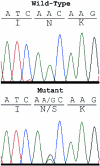A kinesin heavy chain (KIF5A) mutation in hereditary spastic paraplegia (SPG10)
- PMID: 12355402
- PMCID: PMC385095
- DOI: 10.1086/344210
A kinesin heavy chain (KIF5A) mutation in hereditary spastic paraplegia (SPG10)
Abstract
We have identified a missense mutation in the motor domain of the neuronal kinesin heavy chain gene KIF5A, in a family with hereditary spastic paraplegia. The mutation occurs in the family in which the SPG10 locus was originally identified, at an invariant asparagine residue that, when mutated in orthologous kinesin heavy chain motor proteins, prevents stimulation of the motor ATPase by microtubule-binding. Mutation of kinesin orthologues in various species leads to phenotypes resembling hereditary spastic paraplegia. The conventional kinesin motor powers intracellular movement of membranous organelles and other macromolecular cargo from the neuronal cell body to the distal tip of the axon. This finding suggests that the underlying pathology of SPG10 and possibly of other forms of hereditary spastic paraplegia may involve perturbation of neuronal anterograde (or retrograde) axoplasmic flow, leading to axonal degeneration, especially in the longest axons of the central nervous system.
Figures



Comment in
-
Is the transportation highway the right road for hereditary spastic paraplegia?Am J Hum Genet. 2002 Nov;71(5):1009-16. doi: 10.1086/344206. Epub 2002 Sep 24. Am J Hum Genet. 2002. PMID: 12355399 Free PMC article. Review.
Similar articles
-
Kinesins in neurological inherited diseases: a novel motor-domain mutation in KIF5A gene in a patient from Southern Italy affected by hereditary spastic paraplegia.Acta Neurol Belg. 2018 Dec;118(4):643-646. doi: 10.1007/s13760-018-1039-0. Epub 2018 Nov 9. Acta Neurol Belg. 2018. PMID: 30411208
-
Mutations in the motor and stalk domains of KIF5A in spastic paraplegia type 10 and in axonal Charcot-Marie-Tooth type 2.Clin Genet. 2012 Aug;82(2):157-64. doi: 10.1111/j.1399-0004.2011.01717.x. Epub 2011 Jun 21. Clin Genet. 2012. PMID: 21623771
-
Role of kinesin-1 in the pathogenesis of SPG10, a rare form of hereditary spastic paraplegia.Neuroscientist. 2013 Aug;19(4):336-44. doi: 10.1177/1073858412451655. Epub 2012 Jul 10. Neuroscientist. 2013. PMID: 22785106 Review.
-
SPG10 is a rare cause of spastic paraplegia in European families.J Neurol Neurosurg Psychiatry. 2008 May;79(5):584-7. doi: 10.1136/jnnp.2007.137596. Epub 2008 Feb 1. J Neurol Neurosurg Psychiatry. 2008. PMID: 18245137
-
Evidence of kinesin heavy chain (KIF5A) involvement in pure hereditary spastic paraplegia.Neurology. 2004 Sep 28;63(6):1108-10. doi: 10.1212/01.wnl.0000138731.60693.d2. Neurology. 2004. PMID: 15452312 Review.
Cited by
-
Enhanced β-secretase processing alters APP axonal transport and leads to axonal defects.Hum Mol Genet. 2012 Nov 1;21(21):4587-601. doi: 10.1093/hmg/dds297. Epub 2012 Jul 27. Hum Mol Genet. 2012. PMID: 22843498 Free PMC article.
-
Synaptic Vesicle Precursors and Lysosomes Are Transported by Different Mechanisms in the Axon of Mammalian Neurons.Cell Rep. 2020 Jun 16;31(11):107775. doi: 10.1016/j.celrep.2020.107775. Cell Rep. 2020. PMID: 32553155 Free PMC article.
-
Disruption of axonal transport in motor neuron diseases.Int J Mol Sci. 2012;13(1):1225-1238. doi: 10.3390/ijms13011225. Epub 2012 Jan 23. Int J Mol Sci. 2012. PMID: 22312314 Free PMC article. Review.
-
Retrolinkin, a membrane protein, plays an important role in retrograde axonal transport.Proc Natl Acad Sci U S A. 2007 Feb 13;104(7):2223-8. doi: 10.1073/pnas.0602222104. Epub 2007 Feb 7. Proc Natl Acad Sci U S A. 2007. PMID: 17287360 Free PMC article.
-
Mutation in KIF5A c.610C>T Causing Hereditary Spastic Paraplegia with Axonal Sensorimotor Neuropathy.Case Rep Neurol. 2018 Jul 4;10(2):165-168. doi: 10.1159/000490456. eCollection 2018 May-Aug. Case Rep Neurol. 2018. PMID: 30057544 Free PMC article.
References
Electronic-Database Information
-
- EMBL-EBI European Bioinformatics Institute, http://www.ebi.ac.uk/clustalw/ (for ClustalW)
-
- UCSC Genome Bioinformatics, http://genome.cse.ucsc.edu/ (for working draft human genome sequence database)
References
-
- Ashley-Koch A, Bonner ER, Gaskell PC, West SG, Tim R, Wolpert CM, Jones R, Farrell CD, Nance M, Svenson IK, Marchuk DA, Boustany RM, Vance JM, Scott WK, Pericak-Vance MA (2001) Fine mapping and genetic heterogeneity in the pure form of autosomal dominant familial spastic paraplegia. Neurogenetics 3:91–97 - PubMed
-
- Errico A, Ballabio A, Rugarli, EI (2002) Spastin, the protein mutated in autosomal dominant hereditary spastic paraplegia, is involved in microtubule dynamics. Hum Mol Genet 11:153–163 - PubMed
-
- Fink JK (2002) Hereditary spastic paraplegia: the pace quickens. Annals of Neurology 51:669–672 - PubMed
-
- Goldstein LSB, Yang Z (2000) Microtubule-based transport systems in neurons: the roles of kinesins and dynamins. Annu Rev Neurosci 23:39–71 - PubMed
Publication types
MeSH terms
Substances
Associated data
- Actions
- Actions
- Actions
- Actions
- Actions
- Actions
- Actions
- Actions
- Actions
Grants and funding
LinkOut - more resources
Full Text Sources
Other Literature Sources
Molecular Biology Databases

